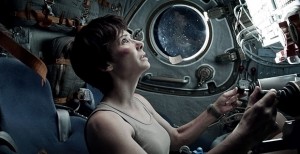Gravity leaves viewers feeling breathless
Superficially, the subject matter in Alfonso Cuarón’s Gravity is not especially original. Movies such as Solaris, 2001: A Space Odyssey and Apollo 13 deal with the challenges facing astronauts in space. Gravity focuses on two astronauts, played by George Clooney and Sandra Bullock, and the pair’s struggle to survive after disaster strikes during a Hubble Space Telescope repair mission. As the captivating trailers for Gravity show, their routine spacewalk repair of the satellite is suddenly hit by a devastating cloud of debris transforming the routine into a disaster.

No air · Sandra Bullock plays Dr. Ryan Stone in Gravity, an intense thriller about a Hubble Space Telescope repair expedition that goes awry. Bullock’s performance draws the audience in and elevates the tension of the film. – Courtesy of Warner Bros. Press
Murphy’s law has a field day in this film — everything that could possibly go wrong, does, often in quick succession. The astronauts are constantly at odds with the utterly inhospitable environment around them as they fight to survive. In the main scene from the trailers, Bullock’s character gets knocked off the shuttle and finds herself spinning off into a darkness threatening to swallow her whole. Intercutting agoraphobic shots of Bullock shrinking into the formless void of space and another from her point of view where bewildering, weightless spinning inside her claustrophobic helmet frames her flight away from her shuttle, Bullock’s terror is palpable and her performance is gripping throughout the film.
Despite Bullock’s powerful performance, however, space and its lack of gravity are the real stars of this film. They are the source of both the film’s terror and its stunning beauty. That terror arises from not only the enveloping nothingness, but also the sheer unpredictability of the environment. One would think that an environment whose primary characteristic is emptiness would not exhibit such volatility, but it is that emptiness, of not only objects, but also rules that makes it so much more alien than any alien planet visited in the realm of movies. Where a planet will have new and strange characteristics, the emptiness of space, and its absence of gravity or frame of reference, blows it out of the water when it comes to unfamiliarity.
In Gravity, the monster is the emptiness — be it the constant threat it poses to the astronaut’s shuttle or the threat of getting lost in its black endlessness. This high-wire act of balancing the fears from wide-open spaces colors the succession of disasters that befall the astronauts and it makes for a very capable catalyst for the story’s progression.
The movie’s title alone should tip you off on the film’s focus on gravity or, more accurately, its absence. That weightlessness dominates the action. But it also gives the film a majestic quality. Using 3-D with a virtuosity that other directors have not been able to achieve, Cuarón uses the lack of gravity to create a weightless ballet in the midst of that constant visceral action. The movements of Bullock and Clooney, floating serenely at first and then with a calmness that belies the urgency of their crisis, are by far the most important part of their performances, despite the stellar job they did with the actual dialogue and desperation. Hanging from super thin wires inside of a state-of-the-art LED cube, they simulated weightlessness marvelously. The movement’s contrast with the urgency of the situation is marvelous, especially with incredible shots of the earth and stars filling the field of vision on a theater screen. In one scene, time is running out. Bullock counts down her oxygen levels as they try to get to the station “3 percent … 2 percent …. 1 percent …” this is a criminally tense moment, but Cuarón splices it with an arresting view of the Earth at night behind them.
This is what makes the film an instant classic. Amid the chaos, amid the struggle, amid the rabid fight for life, you see such serene splendor that it is hard not to be swept up in it. In the same way the amazing desert shots in Lawrence of Arabia take your breath away between scenes of war and conflict, so does this incredible depiction of space. David Lean, the director of Lawrence, achieved his magnum opus by actually going to Jordan and filming in the desert. Cuarón was not lucky enough to go into orbit for his film. That, however, almost makes his achievement more amazing: the knowledge that with movie magic he was able to create such a striking depiction of space.
It is very easy to drift into superlatives and call a movie of Gravity’s caliber “great” for several paragraphs without really delving into the reasons why you think so. The film is a gripping, mesmerizing cinematic experience that is unlike any other film I have seen. Simply put, it is a masterpiece. Watch it on the biggest screen you can find, preferably in 3-D, and prepare to have your breath taken away.
Follow us on Twitter @dailytrojan

Saw 3D IMAX version last evening….Amazing and Gripping film. One of the ways I have always (40 years of watching American films in theatres) used to judge whether a film is able to grip and move an audience is whether sudden movements, or emotional scenes and technical realism feel real…and cause me to get “caught up” in the story and forget that the actors are “celebrities”…in other words-forget the technical details, forget the personal life story of the actor.
This happened in this film in the first 15 minutes. this has not often happened in my life of watching films. I am an educated cinema professional and fell into the magic of this film almost immediately.
This is a winner.